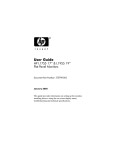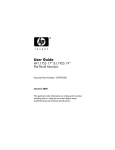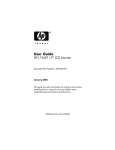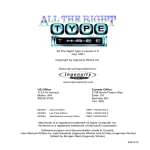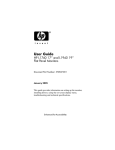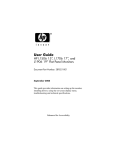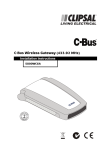Download HP f1903 User's Manual
Transcript
User’s Guide f1903 LCD Monitor The information in this document is subject to change without notice. Hewlett-Packard® Company makes no warranty of any kind with regard to this material, including, but not limited to, the implied warranties of merchantability and fitness for a particular purpose. HP shall not be liable for errors contained herein or for incidental or consequential damages in connection with the furnishing, performance, or use of this material. THE WARRANTY TERMS CONTAINED IN THIS STATEMENT, EXCEPT TO THE EXTENT LAWFULLY PERMITTED, DO NOT EXCLUDE, RESTRICT OR MODIFY AND ARE IN ADDITION TO ANY MANDATORY STATUTORY RIGHTS APPLICABLE TO THE SALE OF THIS PRODUCT OR SERVICE TO YOU. HP assumes no responsibility for the use or reliability of its software on equipment that is not furnished by HP. This document contains proprietary information that is protected by copyright. All rights are reserved. No part of this document may be photocopied, reproduced, or translated to another language without the prior written consent of HP. Hewlett-Packard Company P.O. Box 4010 Cupertino, CA 95015-4010 USA © 2003 Hewlett-Packard Development Company, L.P. All rights reserved. Hewlett-Packard is a registered trademark of Hewlett-Packard Company in the United States of America and other countries/regions. Å WARNING: Text set off in this manner indicates that failure to follow directions could result in bodily harm or loss of life. Ä CAUTION: Text set off in this manner indicates that failure to follow directions could result in damage to equipment or loss of information. Contents 1 Product Features 2 Safety and Maintenance Guidelines Important Safety Information Maintenance Guidelines . . . Cleaning the Monitor. . . Shipping the Monitor . . . . . . . . . . . . . . . . . . . . . . . . . . . . . . . . . . . . . . . . . . . . . . . . . . . . . . . . . . . . . . . . . . . 2–1 2–2 2–3 2–3 Selecting the Signal Connectors and Cables. Connecting Speakers. . . . . . . . . . . . . . . . . Removing the Monitor Base . . . . . . . . . . . . Mounting the Monitor . . . . . . . . . . . . . . . . . . . . . . . . 3–6 3–6 3–7 3–8 . . . . . . . . . . . . 4–1 4–4 4–5 4–6 4–8 4–9 3 Setting Up the Monitor 4 Operating the Monitor Installing the Drivers . . . . . . . . . . . . . . Front Panel Components . . . . . . . . . . . Adjusting Monitor Settings . . . . . . . Using the On-Screen Display . . . . . Using the Auto-Adjustment Function . Optimizing Analog Video . . . . . . . User’s Guide . . . . . . . . . . . . . . . . . . . . . . . . . . . . . . . . . . . . iii A Troubleshooting Solving Common Problems . . . . . . . . . . . . . . . . . A–1 Using the World Wide Web . . . . . . . . . . . . . . . . A–3 Preparing to Call Technical Support . . . . . . . . . . . A–3 B Technical Specifications Recognizing Preset Display Resolutions LCD Monitor Quality and Pixel Policy for f1903 Monitor . . . . . . . . . . . . . . . Entering User Modes . . . . . . . . . . . . . Energy Saver Feature. . . . . . . . . . . . . . . . . . . B–3 . . . . . . B–4 . . . . . . B–5 . . . . . . B–5 C Agency Regulatory Notices Federal Communications Commission Notice. . . . . Modifications . . . . . . . . . . . . . . . . . . . . . . . . Cables. . . . . . . . . . . . . . . . . . . . . . . . . . . . . Declaration of Conformity for Products Marked with FCC Logo, United States Only . . . . . . . . . . . . Canadian Notice . . . . . . . . . . . . . . . . . . . . . Avis Canadien . . . . . . . . . . . . . . . . . . . . . . . European Notice. . . . . . . . . . . . . . . . . . . . . . Japanese Notice . . . . . . . . . . . . . . . . . . . . . . Korean Notice . . . . . . . . . . . . . . . . . . . . . . . EPA Energy Star Compliance . . . . . . . . . . . . . Power Cord Set Requirements . . . . . . . . . . . . . . . C–1 C–2 C–2 C–2 C–3 C–3 C–3 C–3 C–4 C–4 C–5 D TCO ‘03 Requirements Congratulations!. Ergonomics . Energy . . . . . Emissions . . . Ecology . . . . iv . . . . . . . . . . . . . . . . . . . . . . . . . . . . . . . . . . . . . . . . . . . . . . . . . . . . . . . . . . . . . . . . . . . . . . . . . . . . . . . . . . . . . . . . . . . . . . . . . . . . . . . . . . . . . . . . . . . . . . . . D–1 D–1 D–2 D–2 D–2 User’s Guide 1 Product Features The f1903 LCD Monitor has an active matrix, thin-film transistor (TFT), liquid crystal display (LCD). The monitor features include: ■ Large 19-inch (48.3 cm) viewable area display. ■ 1280 × 1024 factory-set resolution, plus full-screen support for lower resolutions. ■ Wide viewing angle to allow viewing from a sitting or standing position, or for moving from one side of the monitor to the other side of the monitor. ■ Tilt adjustment capabilities. ■ Removable base for flexible mounting solutions. ■ Multiple video inputs supported: ❏ VGA Analog ❏ DVI-I supports either Analog or Digital signal input ■ VGA analog and DVI-Digital signal cables included. ■ Plug and Play capability if supported by your system. ■ On-Screen Display (OSD) adjustments in English, French, German, Italian, Spanish, and Dutch for ease of setup and screen optimization. ■ This CD includes an information file (INF), Image Color Matching file (ICM), auto-adjustment pattern software, and this user guide. ■ Energy Saver feature for Energy Star compliance. User’s Guide 1–1 Product Features ■ Compliant with the following regulated specifications: ❏ EPA ENERGY STAR ❏ European Union CE Directives ❏ Swedish MPR II 1990 ❏ Swedish TCO ‘03 With select models, the monitor comes with a set of Harmon Kardon speakers with a separate power supply. 1–2 User’s Guide 2 Safety and Maintenance Guidelines Important Safety Information A power cord is included with your monitor. If another cord is used, use only a power source and connection appropriate for this monitor. For information on the correct power cord set to use with your monitor, refer to the “Power Cord Set Requirements” section in Appendix C. Å WARNING: To reduce the risk of electric shock or damage to your equipment, do not disable the power cord grounding feature. This equipment is designed to be connected to a grounded (earthed) power outlet that is easily accessible to the operator. The grounding plug is an important safety feature. Å WARNING: For your safety, be sure that the power outlet you plug the power cord into is easily accessible and located as close to the equipment as possible. When you need to disconnect the power to the equipment, unplug the power cord from the power outlet by grasping the plug firmly. Never pull on the cord. Ä CAUTION: For the protection of your monitor, as well as your computer, connect all power cords for your computer and its peripheral devices (such as a monitor, printer, scanner) to some form of surge protection device such as a power strip or Uninterruptible Power Supply (UPS). Not all power strips provide surge protection; the power strips must be specifically labeled as having this ability. Use a power strip whose manufacturer offers a Damage Replacement Policy so you can replace your equipment if surge protection fails. User’s Guide 2–1 Safety and Maintenance Guidelines Maintenance Guidelines To enhance the performance and extend the life of your monitor: Ä 2–2 ■ Do not open your monitor cabinet or attempt to service this product yourself. Adjust only those controls that are covered in the operating instructions. If your monitor is not operating properly or has been dropped or damaged, contact your HP authorized dealer, reseller, or service provider. ■ Adjust only those controls that are discussed in the operating instructions. ■ Use only a power source and connection appropriate for this monitor, as indicated on the label/back plate of the monitor. ■ Be sure the total ampere rating of the products connected to the outlet does not exceed the current rating of the electrical outlet, and the total ampere rating of the products connected to the cord does not exceed the rating of the cord. Look on the power label to determine the ampere rating (AMPS or A) for each device. ■ Install your monitor near an outlet that you can easily reach. Disconnect the monitor by grasping the plug firmly and pulling it from the outlet. Never disconnect the monitor by pulling the cord. ■ Turn your monitor off when not in use. You can substantially increase the life expectancy of your monitor by using a screen saver program and turning off the monitor when not in use. ■ Unplug your monitor from the wall outlet before cleaning. Do not use liquid cleaners or aerosol cleaners. Use a damp cloth for cleaning. If the screen requires additional cleaning, use an antistatic screen cleaner. CAUTION: Do not use benzene, thinner, ammonia, or any other volatile substances to clean your monitor or the screen. These chemicals may damage the cabinet finish as well as the screen. User’s Guide Safety and Maintenance Guidelines ■ Slots and openings in the cabinet are provided for ventilation. These openings must not be blocked or covered. Never push objects of any kind into cabinet slots or other openings. ■ Do not drop your monitor or place it on an unstable surface. ■ Do not allow anything to rest on the power cord. Do not walk on the cord. ■ Keep your monitor in a well-ventilated area, away from excessive light, heat or moisture. ■ When removing the monitor base, you must lay the monitor face down on a soft area to prevent it from getting scratched, defaced, or broken. Cleaning the Monitor To clean the monitor, follow these steps: 1. Turn off the monitor and the computer. 2. Dust the monitor by wiping the screen and the cabinet with a soft, clean cloth. If the screen requires additional cleaning, use a clean cloth dampened with isopropyl alcohol. Ä CAUTION: Do not use benzene, thinner, ammonia, or any volatile substance to clean the monitor screen or cabinet. These chemicals may damage the monitor. Never use water to clean an LCD screen. Shipping the Monitor Keep the original packing box in a storage area. You may need it later if you move or ship your monitor. User’s Guide 2–3 Safety and Maintenance Guidelines 2–4 User’s Guide 3 Setting Up the Monitor To set up the monitor, ensure that the power is turned off to the monitor, computer system, and other attached devices, then follow these steps: 1. Place the monitor in a convenient, well-ventilated location near your computer. 2. Connect one end of the monitor signal cable to the video connector on the rear panel of the computer, and the other end to the back of the monitor. Connecting the VGA Signal Cable User’s Guide 3–1 Setting Up the Monitor DVI-D cable supplied with this monitor is for digital-to-digital ✎ The connection only. Your computer must have a DVI-compatible graphics card installed for use with this cable. When connecting the DVI-D signal cable to the DVI connector on the monitor, you must connect the other end of the DVI-D cable to the DVI connector on the computer. Connect one end of the power cable to the back of the monitor, and the other end to an electrical wall outlet. Connecting the DVI-D Signal Cable 3–2 User’s Guide Setting Up the Monitor 3. Connect one end of the power cable to the back of the monitor, and the other end to a power source. Connecting the Power Cable User’s Guide 3–3 Setting Up the Monitor 4. Adjust the monitor as needed for your comfort using the monitor’s tilt, swivel, and height adjustment capabilities. -5˚ 20˚ -35˚ 35˚ 3–4 User’s Guide Setting Up the Monitor Å WARNING: To reduce the risk of electric shock or damage to your equipment: Do not disable the power cord grounding plug. The grounding plug is an important safety feature. Plug the power cord into a grounded (earthed) electrical outlet that is easily accessible at all times. Disconnect power from the monitor by unplugging the power cord from the electrical outlet. Do not place anything on power cords or cables. Arrange them so that no one may accidentally step on or trip over them. Do not pull on a cord or cable. When unplugging from the electrical outlet, grasp the cord by the plug. Ä CAUTION: Burn-in image damage may occur on monitors that display the same static image on screen for a prolonged period of time. To avoid burn-in image damage on your monitor screen, you should always activate a screen saver application or turn off the monitor when it is not in use for a prolonged period of time. User’s Guide 3–5 Setting Up the Monitor Selecting the Signal Connectors and Cables There are two signal input connectors: One VGA connector and one DVI-I connector. The monitor will automatically determine which inputs have valid video signals. The inputs can be selected through the On-Screen Display (OSD) feature or by pressing the Signal Input 1 or 2 buttons on the monitor front bezel. The video mode supported by the DVI-I connector is determined by the video cable used. For digital operation, use the DVI-D to DVI-D signal cable provided. For analog operation, a DVI-A to VGA signal cable must be attached to the DVI-I input (not provided with the monitor). Connecting Speakers A set of speakers are included with your monitor (select models only). 1. Place the speakers in a location near the monitor. 2. Plug the right speaker into the main power source. 3. Plug the right speaker audio cable (green plug) into the PC. Refer to your PC user’s guide for instructions on how to connect your speakers to the PC. 4. Turn on the PC, the monitor, and the speakers. 3–6 User’s Guide Setting Up the Monitor Removing the Monitor Base You can remove the monitor base to mount the monitor on a wall, a swing arm or other mounting fixture. Read the caution and warning statements below before beginning the procedure. Ä CAUTION: Before beginning to disassemble the monitor, be sure the monitor is turned off and the power and signal cables are both disconnected. Lay the front bezel down on a soft area to prevent it from getting scratched, defaced, or broken. Å WARNING: Do not remove the base from the monitor while the monitor is in the upright position. Before removing the monitor from the base, ensure that the monitor is lying flat, front bezel down, and that the base is set to the maximum base extension. Attempting to remove the monitor from the base while it is upright in the minimum base extension may result in injury to the user. User’s Guide 3–7 Setting Up the Monitor 1. Disconnect and remove the signal and power cables from the back of the monitor. 2. Remove the four screws as shown in the following illustration. Ä CAUTION: Ensure that the bottom of the monitor base is positioned over a table or desktop before removing the base from the monitor. 3. Remove the monitor base from the monitor. Mounting the Monitor 1. Remove the monitor base. Refer to “Removing the Monitor Base” steps in the previous section. When the base has been removed, four threaded mounting holes are exposed on the monitor panel. These are to be used for mounting purposes. These mounting holes are spaced 100 mm apart and are compliant with the Video Electronics Standards Association (VESA) standard for mounting flat panel displays. 2. Mount the monitor to a swing arm or other mounting fixture by following the instructions included with the mounting fixture to be used. 3–8 User’s Guide 4 Operating the Monitor Installing the Drivers The monitor comes with driver software allowing you to take advantage of the Plug and Play feature of the Microsoft® Windows® Me, Windows 2000, or Windows XP operating system. This software enables the computer to communicate with the monitor and use all the monitor features. Without this software, the monitor settings and display images cannot be correct. computers may come with the Plug and Play drivers ✎ HP preinstalled. If you have an older computer, these drivers may not be preinstalled and you may need to install the drivers from the CD-ROM disc that came with the monitor. You can also download the latest version of a driver from the HP Monitors Support Web site. Go to http://www.hp.com select your country/region, and then follow the links to the support page for monitors. Windows 2000 users procedure for installing the driver for your operating system ✎ The may vary from this. To install the driver for the f1903 monitor: 1. Click Start, select Settings, and then click Control Panel. 2. Double-click Display. User’s Guide 4–1 Operating the Monitor 3. Click the Settings tab. 4. Click Advanced Properties or Advanced, and select the Monitor tab. 5. Click Properties. 6. Click the Driver tab. 7. Click Update Driver and click Next. 8. Select the recommended option and then click Next. 9. Select the Specify a Location box and then click Next. 10. Find and open the hp_f1903.inf file on the CD-ROM disc in the Drivers directory, and click OK. 11. Click Next to install the selected monitor. Windows Me users procedure for installing the driver for your operating system ✎ The may vary from this. To install the driver for the f1903 monitor: 1. Click Start, select Settings, and then click Control Panel. 2. Double-click Display. 3. Select the Settings tab. 4. Click the Advanced button. 5. Select the Monitor tab. 6. Click the Change button. 7. Select the Specify the location of the driver box and then click Next. 8. Click Next. 9. Find and open the hp_f1903.inf file on the CD-ROM disc in the Drivers directory, and click OK. 10. Click Next to install the selected monitor. 4–2 User’s Guide Operating the Monitor Windows XP users procedure for installing the driver for your operating system ✎ The may vary. To install the driver for the f1903 monitor: 1. Click Start. 2. Click Control Panel. 3. Click Appearance and Themes. 4. Click Display. 5. Select the Settings tab. 6. Click the Advanced button. 7. Select the Monitor tab. 8. Click Properties. 9. Select the Driver tab. 10. Click Update Driver. 11. Select the Install from a list or specific location box and then click Next. 12. Select the Don’t search box and then click Next. 13. Click Have Disk. 14. Click Browse. 15. Find and open the hp_f1903.inf file on the CD-ROM disc in the Drivers directory, and click OK. 16. Click Next to install the selected monitor. If the installation procedure of the monitor driver for the Windows 2000, Windows Me, or Windows XP operating system is different, or if you need more detailed installation information, please refer to the Microsoft Windows information that came with the computer. User’s Guide 4–3 Operating the Monitor Front Panel Components 2 3 4 5 1 ‘ No. Control 1 On/Off 2 Menu Function Turns the monitor on and off • When OSD is active, closes setting screens and exits OSD. • When OSD is inactive, opens and closes OSD. 3 Left or Down Browse/ Input 1 • When OSD is active, navigates OSD settings menu and adjusts settings. • When OSD is inactive, selects the VGA signal input setting. 4 Right or Up Browse/ Input 2 • When OSD is active, navigates OSD settings menu and adjusts settings. • When OSD is inactive, selects the DVI-I signal input setting. 5 Select/Auto • When OSD is active, acts as an Enter (Select) key to select setting screen options. • When OSD is inactive, performs an auto-adjustment to optimize image quality. 4–4 User’s Guide Operating the Monitor Adjusting Monitor Settings Press the menu button on the front panel of your monitor to view the On-Screen Display (OSD) Menu. The Main Controls window pops up and you can make adjustments to your monitor’s various features. Use the left arrow and right arrow keys in the menu window to make your adjustments. User’s Guide 4–5 Operating the Monitor Using the On-Screen Display The adjustments for screen settings are located in the On-Screen Display (OSD) menus. Two OSD menus are available; one for basic adjustments, and one for advanced adjustments. To access the Basic OSD Menu, press the Menu button on the monitor’s front panel. Basic OSD Menu Levels Menu Level 1 Menu Level 2 Brightness Adjustment Scale Contrast Adjustment Scale Auto Adjustment Advanced Menu Exit To access the Advanced OSD Menu, press the menu button again, or select Advanced Menu from the Basic OSD Menu. selecting the Advanced Menu from the Basic Menu, the ✎ After Advanced Menu remains the default OSD on subsequent power-ups of the monitor until the Basic Menu is selected or Factory Reset is applied. The Advanced OSD Menu has up to two sublevels and can be viewed in one of six available languages. The following table provides the menus and their functions at each level: Advanced OSD Menu Levels Level 1 4–6 Level 2 Brightness Adjustment Scale Contrast Adjustment Scale Level 3 User’s Guide Operating the Monitor Advanced OSD Menu Levels Level 1 Image Control Level 2 Level 3 Auto Adjustment “Adjusting Message” Horizontal Position Adjustment Scale Vertical Position Adjustment Scale Clock Adjustment Scale Clock Phase Adjustment Scale Cancel Save and Return ✎ The Video Clock and Clock Phase selections are not available when the monitor is operating in the DVI-D (digital) mode. Color 9300 K 6500 K Custom Color RGB Color Adjustment Cancel Save and Return Language Deutsche English Espanol Francais Italiano Nederlands Cancel Save and Return Management Power Saver On/Off Selection Power On Recall On/Off Selection Mode Display On/Off Selection Serial Number (display serial no.) Basic Menu Cancel Save and Return User’s Guide 4–7 Operating the Monitor Advanced OSD Menu Levels Level 1 OSD Control Level 2 Level 3 Horizontal Position Adjustment Scale Vertical Position Adjustment Scale OSD Timeout Adjustment Scale OSD Transparency Adjustment Scale Cancel Save and Return Video Input Controls Input Selection Analog (D-SUB) Analog (DVI) Digital (DVI) Auto Detect Cancel Save and Return Factory Reset Yes No Exit Using the Auto-Adjustment Function You can easily optimize the screen performance for the VGA interface by using the Auto button and the auto-adjustment pattern software on the CD-ROM disc provided. 1. Insert the provided CD-ROM disc into the computer. 2. Run the software file Adjustment pattern.exe (from the CD-ROM drive) to display a setup test pattern. 3. Press the Auto button to produce a stable, centered image. The optimizer utility on the CD-ROM contains the drivers for Windows Me, Windows 2000, or Windows XP. For the f1903 monitor, use the D:\Drivers\hp_f1903.inf (or E:\Drivers\hp_f1903.inf) file. 4–8 User’s Guide Operating the Monitor Optimizing Analog Video This monitor contains advanced circuitry that allows the flat panel screen to function as a standard monitor. Two controls in the on-screen display can be adjusted to improve image performance: Clock and Clock Phase. Use these controls only when the auto-adjust function does not provide a satisfactory image. Clock must first be set correctly since the Clock Phase settings ✎ The are dependent on the main Clock setting. ■ Clock — Increase or decrease the value to minimize any vertical bars or stripes visible on the screen background. ■ Clock Phase — Increase or decrease the value to minimize video distortion or video jitter. using the controls, you will obtain the best results by using ✎ When the adjustment pattern application provided on the CD-ROM. adjusting the Clock and Clock Phase values, if the monitor ✎ When images become distorted, continue adjusting the values until the distortion disappears. To restore the factory settings, select Yes from the Factory Reset menu in the on-screen display. User’s Guide 4–9 Operating the Monitor 4–10 User’s Guide A Troubleshooting Solving Common Problems The following table lists possible problems, the possible cause of each problem, and the recommended solutions. Problem Possible Cause Solution Screen is blank. Power cord is disconnected. Connect the power cord. Power switch is turned off. Turn on the power. Video cable is improperly connected. Connect the video cable properly. Refer to Chapter 3, “Setting Up the Monitor,” for more information. Screen blanking utility is active. Press any key on the keyboard or move the mouse to turn off the screen blanking utility. Brightness and contrast are too low. Press the Auto button on the front panel. If this does not correct the image, press the Menu button to open the Basic OSD Menu, and adjust the brightness and contrast scales as needed. Image appears blurred, indistinct, or too dark. User’s Guide A–1 Troubleshooting Problem Possible Cause Solution Image is not centered. Position may need adjustment. Press the Menu button to access the OSD Menu. Select Image Control/ Horizontal Position or Vertical Position to adjust the horizontal or vertical position of the image. “No Connection, Check Signal Cable” is displayed on screen. Monitor video cable is disconnected. Connect the 15-pin monitor video cable to the VGA connector on the computer, or connect the DVI-D signal cable to the DVI connector on the computer. Be sure that the computer power is off while connecting the video cable. “Out of Range. Set Monitor to 1280 x 1024 @ 60Hz” is displayed on screen. Video resolution and/or refresh rate are set higher than what your monitor supports. Restart your computer and enter Safe Mode. Change your settings to a supported setting (see the table “Factory Preset Display Modes” in Appendix B). Restart your computer so that the new settings take effect. A–2 User’s Guide Troubleshooting Using the World Wide Web Before contacting customer services, refer to the support Web site at: http://www.hp.com Preparing to Call Technical Support If you cannot solve a problem using the troubleshooting tips in this section, you may need to call technical support. Have the following available when you call: ■ The monitor ■ Monitor model number ■ Serial number for the monitor ■ Purchase date on invoice ■ Conditions under which the problem occurred ■ Error messages received ■ Hardware configuration ■ Name and version of the hardware and software you are using User’s Guide A–3 Troubleshooting A–4 User’s Guide B Technical Specifications f1903 Flat Panel Monitor Display Type 19.0 inches TFT LCD 48.3 cm Viewable Image Size 19.0-inch diagonal 48.3 cm Tilt Swivel –5 to 20o +35 to –35o Face Treatment Anti-glare polarizer with hard coating Maximum Weight (Unpacked) 17.2 lbs. 7.8 kg (unpacked) Dimensions (include pedestal) Height (min) Height (max) Depth Width 15.8 inches 20.6 inches 8.5 inches 16.6 inches Maximum Graphics Resolution 1280 x 1024 (75 Hz) analog and digital modes Text Mode 720 x 400 Dot Pitch 0.294 x 0.294 mm User’s Guide 400.0 525.0 215.4 422.5 mm mm mm mm B–1 Technical Specifications f1903 Flat Panel Monitor (Continued) Horizontal Frequency (analog mode) 30 to 82 kHz Vertical Refresh Rate (analog mode) 56 to 76 Hz Environmental Requirements Temperature: Operating Temperature Non-operating Temperature 41to 95o F –4 to 140o F Relative Humidity 20 to 80% Power Source 100–240 VAC, 50/60 Hz Power Consumption <40 watts typical Input Terminals 15-pin D-type connector with cable included DVI-I connector with DVI-D cable included 5 to 35o C –20 to 60o C All performance specificatons are provided by the component manufacturer. Performance specifications represent component manufacturer averages and actual performance may vary. B–2 User’s Guide Technical Specifications Recognizing Preset Display Resolutions The display resolutions listed below are the most commonly used modes and are set as factory defaults. This monitor automatically recognizes these preset modes and they will appear properly sized and centered on the screen. Factory Preset Display Modes Preset Pixel Format Horz Freq (kHz) Vert Freq (Hz) 1 640 x 480 31.5 60.0 2 640 x 480 37.9 72.0 3 640 x 480 37.5 75.0 4 720 x 400 31.5 70.0 5 800 x 600 37.9 60.0 6 800 x 600 48.1 72.0 7 800 x 600 46.9 75.0 8 832 x 624 49.7 75.0 9 1024 x 768 48.4 60.0 10 1024 x 768 60.0 75.0 11 1152 x 870 68.7 75.0 12 1152 x 900 61.8 65.9 13 1280 x 960 60.0 60.0 14 1280 x 1024 63.9 60.0 15 1280 x 1024 80.0 75.0 User’s Guide B–3 Technical Specifications LCD Monitor Quality and Pixel Policy for f1903 Monitor The HP f1903 TFT monitor uses high-precision technology, manufactured according to HP standards, to guarantee trouble-free performance. Nevertheless, the display may have cosmetic imperfections that appear as small bright or dark spots. This is common to all LCD displays used in products supplied by all vendors and is not specific to the HP f1903 displays. These imperfections are caused by one or more defective pixels or sub-pixels. ■ A pixel consists of one red, one green, and one blue sub-pixel. ■ A defective whole pixel is always turned on (a bright spot on a dark background), or it is always off (a dark spot on a bright background). The first is the more visible of the two. ■ A defective sub-pixel (dot defect) is less visible than a defective whole pixel and is small and only visible on a specific background. The HP f1903 display does not have more than: ■ 7 total dot defects ■ 1 defective full pixels ■ 3 defective bright sub-pixels ■ 4 defective dark sub-pixels ■ No more than two adjacent (less than 2.5 mm edge-to-edge) and defective pixels ■ No more than two pairs of two adjacent defective pixels To locate defective pixels, the monitor should be viewed under normal operating conditions and in normal operating mode at a supported resolution and refresh rate, from a distance of approximately 50 cm (16 in.). HP expects that, over time, the industry will continue to improve its ability to produce displays with fewer cosmetic imperfections and HP will adjust guidelines as improvements are made. B–4 User’s Guide Technical Specifications Entering User Modes The video controller signal may occasionally call for a mode that is not preset if: ■ You are not using a standard graphics adapter. ■ You are not using a preset mode. If this occurs, you may need to readjust the parameters of the monitor screen by using the on-screen display. Your changes can be made to any or all of these modes and saved in memory. The monitor automatically stores the new setting, then recognizes the new mode just as it does a preset mode. In addition to the 16 factory preset modes, there are four user modes that can be entered and stored. Energy Saver Feature When the monitor is in its normal operating mode, the monitor uses less than 40 watts of power and the Power light is green. The monitor also supports a reduced power state. The reduced power state will be entered into if the monitor detects the absence of either the horizontal sync signal and/or the vertical sync signal. Upon detecting the absence of these signals, the monitor screen is blanked, the backlight is turned off, and the Power light is turned amber. When the monitor is in the reduced power state, the monitor will utilize less than 2 watts of power. There is a brief warm up period before the monitor will return to its normal operating mode. Refer to your computer manual for instructions on setting energy saver features (sometimes called power management features). above energy saver feature works only when connected to ✎ The computers that have energy saver features. By selecting settings in the monitor’s Energy Saver utility, you can also program the monitor to enter into the reduced power state at a predetermined time. When the monitor’s Energy Saver utility causes the monitor to enter the reduced power state, the Power light blinks amber. User’s Guide B–5 Technical Specifications B–6 User’s Guide C Agency Regulatory Notices Federal Communications Commission Notice This equipment has been tested and found to comply with the limits for a Class B digital device, pursuant to Part 15 of the FCC Rules. These limits are designed to provide reasonable protection against harmful interference in a residential installation. This equipment generates, uses, and can radiate radio frequency energy and, if not installed and used in accordance with the instructions, may cause harmful interference to radio communications. However, there is no guarantee that interference will not occur in a particular installation. If this equipment does cause harmful interference to radio or television reception, which can be determined by turning the equipment off and on, the user is encouraged to try to correct the interference by one or more of the following measures: ■ Reorient or relocate the receiving antenna. ■ Increase the separation between the equipment and the receiver. ■ Connect the equipment into an outlet on a circuit different from that to which the receiver is connected. ■ Consult the dealer or an experienced radio or television technician for help. User’s Guide C–1 Agency Regulatory Notices Modifications The FCC requires the user to be notified that any changes or modifications made to this device that are not expressly approved by Hewlett-Packard Company may void the user’s authority to operate the equipment. Cables Connections to this device must be made with shielded cables with metallic RFI/EMI connector hoods to maintain compliance with FCC Rules and Regulations. Declaration of Conformity for Products Marked with FCC Logo, United States Only This device complies with Part 15 of the FCC Rules. Operation is subject to the following two conditions: (1) this device may not cause harmful interference, and (2) this device must accept any interference received, including interference that may cause undesired operation. For questions regarding your product, contact: Hewlett-Packard Company P. O. Box 692000, Mail Stop 530113 Houston, Texas 77269-2000 Or, call 1-800-474-6836 For questions regarding this FCC declaration, contact: Hewlett-Packard Company P. O. Box 692000, Mail Stop 510101 Houston, Texas 77269-2000 Or, call (281) 514-3333 To identify this product, refer to the part, series, or model number found on the product. C–2 User’s Guide Agency Regulatory Notices Canadian Notice This Class B digital apparatus meets all requirements of the Canadian Interference-Causing Equipment Regulations. Avis Canadien Cet appareil numérique de la classe B respecte toutes les exigences du Règlement sur le matériel brouilleur du Canada. European Notice Products with the CE Marking comply with both the EMC Directive (89/336/EEC) and the Low Voltage Directive (73/23/EEC) issued by the Commission of the European Community. Compliance with these directives implies conformity to the following European Norms (in brackets are the equivalent international standards): ■ EN55022 (CISPR 22) — Electromagnetic Interference ■ EN55024 (IEC61000-4-2,3,4,5,6,8,11) — Electromagnetic Immunity ■ EN61000-3-2 (IEC61000-3-2) — Power Line Harmonics ■ EN61000-3-3 (IEC61000-3-3) — Power Line Flicker ■ EN60950 (IEC950) — Product Safety Japanese Notice User’s Guide C–3 Agency Regulatory Notices Korean Notice EPA Energy Star Compliance Monitors that are marked with the Energy Star® Logo meet the requirements of the EPA Energy Star program. As an Energy Star Partner, Hewlett-Packard Company has determined that this product meets the Energy Star guidelines for energy efficiency. Specific details on using the energy saving features can be found in the energy saver or power management section of the computer manual. C–4 User’s Guide Agency Regulatory Notices Power Cord Set Requirements The monitor power supply is provided with Automatic Line Switching (ALS). This feature allows the monitor to operate on input voltages between 100–120V or 200–240V . The power cord set (flexible cord or wall plug) received with the monitor meets the requirements for use in the country where you purchased the equipment. If you need to obtain a power cord for a different country, you should purchase a power cord that is approved for use in that country. The power cord must be rated for the product and for the voltage and current marked on the product’s electrical ratings label. The voltage and current rating of the cord should be greater than the voltage and current rating marked on the product. In addition, the cross-sectional area of the wire must be a minimum of 0.75 mm² or 18AWG, and the length of the cord must be between 6 feet (1.8 m) and 12 feet (3.6 m). If you have questions about the type of power cord to use, contact your HP authorized service provider. A power cord should be routed so that it is not likely to be walked on or pinched by items placed upon it or against it. Particular attention should be paid to the plug, electrical outlet, and the point where the cord exits from the product. User’s Guide C–5 Agency Regulatory Notices C–6 User’s Guide D TCO ‘03 Requirements Congratulations! The display you have just purchased carries the TCO’03 Display label. This means that your display is designed, manufactured and tested according to some of the strictest quality and environmental requirements in the world. This makes for a high performance product, designed with the user in focus that also minimizes the impact on our natural environment. Some of the features of the TCO’03 Display requirements: Ergonomics ■ User’s Guide Good visual ergonomics and image quality in order to improve the working environment for the user and to reduce sight and strain problems. Important parameters are luminance, contrast, resolution, reflectance, color rendition, and image stability. D–1 TCO ‘03 Requirements Energy ■ Energy-saving mode after a certain time — beneficial both for the user and the environment. ■ Electrical safety. Emissions ■ Electromagnetic fields. ■ Noise emissions. Ecology ■ The product must be prepared for recycling and the manufacturer must have a certified environmental management system such as EMAS or ISO 14000. ■ For information on the HP recycling program, refer to the HP Web site at: http://www.hp.com/hpinfo/globalcitizenship/environment/ recycle/hardware.html ■ Restrictions on: ❏ chlorinated and brominated flame retardants and polymers ❏ heavy metals such as cadmium, mercury and lead The requirements included in this label have been developed by TCO Development in co-operation with scientists, experts, and users as well as manufacturers all over the world. Since the end of the 1980s TCO has been involved in influencing the development of IT equipment in a more friendly direction. Our labelling system started with displays in 1992 and is now requested by users and IT-manufacturers all over the world. For more information, please visit www.tcodevelopment.com D–2 User’s Guide

















































